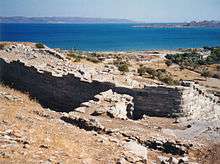Thoricus
Thoricus (or Thorikos) was an ancient Greek city in southern Attica, one of the twelve original settlements that were united in the synoikismos attributed to Theseus to form Archaic Athens. Near it are the mines of Laurion, where lead and silver was mined from Neolithic times, and worked in the industrial quarter of the settlement. [1] There is a theatre dating from c. 525–480 BC. The modern site is Lavrio.
History
The site was inhabited from the Neolithic Age (4th millennium BC). Thoricus was the mining centre of the Laureotica. There is evidence of lead extraction from the Early Helladic period (3rd millennium BC) and of silver (now exhausted) from 1500 BC.[2] Mycenaean tholos tombs (15th century BC) and a Late Mycenaean installation (12th century BC), probably connected with the mines in the area, have been uncovered. The finds are housed in the National Archaeological Museum, Athens.[3]
There were significant town walls and a postern. The town's harbour was to the south of the acropolis; the island of Makronisi (Macri) provides natural protection.[2] The settlement was destroyed by Sulla in 86 BC, and though it was reinhabited in Roman times, and visited by Pausanias, it was permanently abandoned in the 6th century's disorders.
In myth
Thorikos, in the Homeric Hymn to Demeter (probably 7th century BC) is mentioned by the goddess, who is disguised as an old woman, as her landing place when she had been unwillingly brought from Crete. Thorikos directly faces Crete to the south, across the open Aegean Sea.
Cephalus is said to have died at Thoricus.[2]
Remains

The ancient city's centre and its acropolis are on Velatouri hill and the theatre (c. 525-480 BC) (illustration) is a significant survival. The town was closely packed with irregular building of houses and smiths' workshops (many dating from the 7th–4th century BC). A small temple, perhaps dedicated to Hygieia, next to stoas with benches. Inscriptions have identified the large Doric temple (late 5th century BC) as a telesterion for the cult of Demeter and Kore, the "Maiden" her daughter Persephone.[3] The temple was initially explored by the Society of Dilettanti of London in 1817. In April 1886, Walter Miller conducted the first modern excavation of the site, seeking the theater.[4] Modern archaeology here has been largely connected with the Belgian School in Athens.
See also
References
- ↑ Archaeological Site of Thorikos: Overview
- 1 2 3 Wordsworth, Christopher (c. 1839). Athens and Attica. pp. 211–216.
- 1 2 "Thoricus (Thorikos)". Archaeological Atlas of the Aegean.
- ↑ "Papers of the American School of Classical Studies at Athens". University of Michigan Library. 2005. Retrieved April 20, 2008.
Coordinates: 37°44′17″N 24°03′13″E / 37.7381°N 24.0536°E